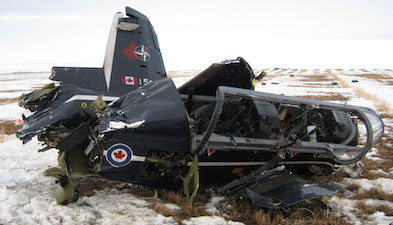CT156102 Harvard ll - Epilogue
Report / January 24, 2014 / Project number: CT156102 - A Cat
Location: 15 Wing Moose Jaw, Saskatchewan
Date: 24 January 2014
Status: Investigation Complete
While conducting an advanced clearhood training sortie in a CT156 Harvard II aircraft out of 2 Canadian Forces Flying Training School (2 CFFTS), a qualified flying instructor (QFI) and student pilot (SP) experienced a hard landing upon completion of a practice forced landing (PFL).
Recognizing that the approach was not ideal, the QFI took control of the aircraft from the student just as the landing gear contacted the runway. The instructor applied full power and the aircraft quickly became airborne again.
A Harvard II chase aircraft joined up to visually inspect and photograph the damage. The photographs were returned to base which allowed maintenance personnel to confirm that the left main landing gear (LMLG) brace had become detached from the strut. Meanwhile, a second Harvard II chase aircraft joined up with the accident aircraft. Several attempts were made by the accident aircraft to attain a symmetrical gear up configuration for a possible belly landing; however, a symmetrical configuration was not achieved.
Supported by the 15 Wing Commander (W Comd), the QFI decided that a controlled ejection was the safest option rather than attempting to land the crippled aircraft. After completing the ejection checklist, the QFI and SP successfully ejected. The QFI and SP suffered minor injuries during the ejection and parachute landing. The aircraft was destroyed in the subsequent crash.
With no evidence of aircraft unserviceability, the investigation focussed primarily on the PFL, which had been flown in a non-standard flapless configuration. The associated training plans (TPs) and PFL training were also examined.
The investigation found that a need to increase pilot production at 2 CFFTS had resulted in a revised TP. The new TP was put into effect coincidental with the QFI’s pilot training in 2012. The revised syllabi made significant modifications to the previous syllabi; most noteworthy was a significant reduction in the number of flying missions that could include PFL training.
The investigation concluded that the practice of completing PFLs in a flapless configuration with no formal training was contributory to this accident, as was the decrease in PFL training which likely resulted in this QFI having significantly less PFL experience following the Flying Instructor Course (FIC) than previous pipeline QFIs in 2 CFFTS.
A preventive measure (PM) was implemented following this accident which established a safety window restricting the practice of flapless PFLs. Additional PMs relating to Aviation Life Support Equipment (ALSE), the Integrated Data Acquisition Recorder (IDAR), QFI personal limits and unit culture are recommended.
